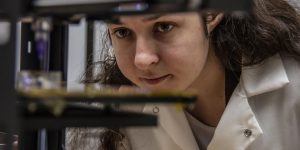 Victoria Webster-Wood, PhD, McGowan affiliated faculty and Assistant Professor in Mechanical Engineering at the University of Pittsburgh with a courtesy appointment in Biomedical Engineering at Carnegie Mellon University (CMU), will head a team of researchers from CMU, Northwestern University, and The Georgia Institute of Technology.
Victoria Webster-Wood, PhD, McGowan affiliated faculty and Assistant Professor in Mechanical Engineering at the University of Pittsburgh with a courtesy appointment in Biomedical Engineering at Carnegie Mellon University (CMU), will head a team of researchers from CMU, Northwestern University, and The Georgia Institute of Technology.
The team received a $6.25 million Multidisciplinary University Research Initiative (MURI) grant from the Department of Defense (DOD).
Comprised of researchers in biomedical engineering, mechanical engineering, electrical engineering, and computer science, the transdisciplinary team will study issues in biohybrid systems.
According to a press release, “the project aims to identify how to combine living materials, protein-based materials and engineered materials to build larger scale, self-sustaining bio-actuators; understand how to keep these materials alive in a real-world environment; and determine how to leverage computational design strategies to improve peak performance.”
As founder and director of CMU’s Biohybrid and Organic Robotics Group (BORG), Dr. Webster-Wood is interested in connections between animals and robotics. Animals have long served as an inspiration for robotics; however, many of the mechanical properties, physical capabilities, and the behavioral flexibility seen in animals have yet to be achieved in robotic platforms. Towards addressing this gap, the BORG’s research focuses on the use of organic materials as structures, actuators, sensors, and controllers toward the development of biohybrid and organic robots and biohybrid prosthetics.
“Right now our biohybrid robots run around in petri dishes and in sterile incubators,” explains Dr. Webster-Wood. “Through this project we hope to leverage our understanding of living muscle to create stronger, more useful muscle-based actuators.”
The research group’s long-term goal is to develop completely organic, autonomous robots with programmable neural circuits. Such robotic systems will have applications in search and rescue, environmental monitoring, and prosthetics. Biohybrid actuators will make it possible for the robots to “grow, develop, and heal as they operate in the real world.”
“This research lays the foundation to move these actuators to translation,” notes Dr. Webster-Wood. “We hope to get living muscle-based actuators to the point where they are reliable and predictable enough that someone can select one, just like they would a motor, and put them to use in a robot.”
Image sourced from Carnegie Mellon University News, May 3, 2023.
